Contents
Pomegranate varieties have a different shape, taste, differ in color. The fruits consist of grains with a small stone inside. They can be sweet and sour. It all depends on the type of shrub, as well as on the place of growth.
Pomegranate is a fruit tree up to 6 m high. There are varieties in the form of a bush. They are characterized by thin, even shoots of a yellow-brown hue. The foliage is round or oblong in shape. The length of the leaf plate is 3-8 cm, and the width is 3 cm. The leaves are held on short petioles, collected in bunches. The trunk is uneven, the bark is covered with small spines.
It blooms luxuriantly and for a long time, from May to August. Inflorescences cone-shaped, bright red hue. The size is 3 cm in diameter. Propagated by cuttings, layering and seeds. In the wild, pomegranates grow in the Caucasus, Central and Asia Minor.
Pomegranate is valued as an ornamental crop, it is also used to create a hedge or bonsai. The purpose of the pomegranate fruit is different. They are grown for the purpose of fresh consumption, technical processing, and juice production.

How many varieties of pomegranate are there
More than 500 cultivated varieties are known. Thanks to the efforts of breeders, there are more and more of them. The main task is to create a plant that will be resistant to diseases and weather changes.
In the Nikitsky Botanical Garden, which is located in the Crimea, near the city of Yalta, there is something to see. There are 340 varieties of pomegranate. Among them are types of domestic selection, as well as crops of foreign origin that do not grow in a temperate climate.
There are even more varieties of pomegranate in Turkmenistan, and more precisely in the Kara-Kala reserve. This is the largest collection in the world. In total, there are 800 types and forms of pomegranate on the territory.
What are the varieties of pomegranate
There are only two species in the pomegranate family – the common pomegranate and the Socotran pomegranate. As a result of hybridization, many varieties and species have appeared. They have a different color of fruits, composition and effects on the body.
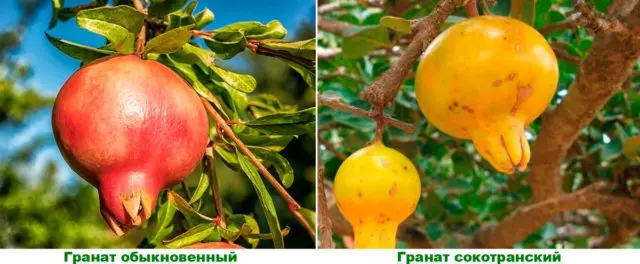
Common pomegranate variety
A perennial tree from a subtropical climate. Life expectancy 50 years. Productivity from one tree is 60 kg. It grows to a height of 5-6 m. The branches are thin, prickly. Leaves are green and glossy. The fruit is similar in size to an orange. The color of the skin is from orange to brown-red. The growing season lasts 6-8 months. Formation and ripening of fruits occurs within 120-150 days.
The pulp and grains contain malic, citric, oxalic acid, vitamin C, sugar, minerals. The peel contains tannins, vitamins, steroids, carbohydrates.
A wild tree is common in the Transcaucasus, Tajikistan, and Uzbekistan.
Socotra pomegranate variety
A native of the island of Socotra. Quite rare in the wild. The evergreen tree grows to a height of 2,5-4,5 m. The shape of the leaves is oblong, rounded. Unlike common pomegranate, it has pink inflorescences, a different structure of the ovary, a smaller fruit, and a low sugar content. Prefers limestone soils. It occurs on rocky plateaus, 250-300 m above sea level. Not cultivated.
According to the variety, pomegranate fruits are distinguished by their appearance. The color of the skin is scarlet, burgundy, sandy yellow, orange. The grains vary in color. Pomegranate varieties are characterized by the intensity of the red color or its absence. There is a pulp of white, light pink, yellow, raspberry or almost black shades. Light varieties of pomegranate have a sweeter taste than dark ones.
yellow pomegranate
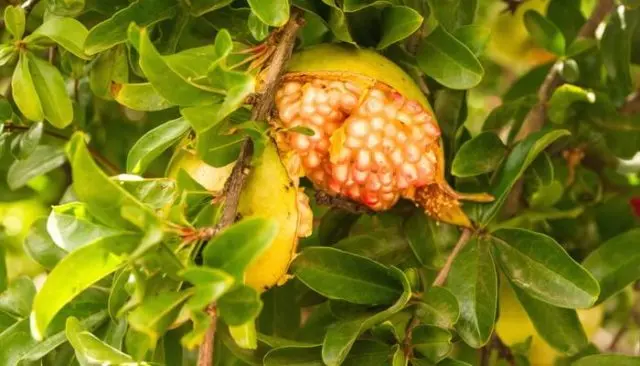
This fruit has the appearance of an unripe fruit. Unusual color attracts a lot of attention. The taste is sweet, one might say, there is no acid at all. The grains are pale pink. The skin is thin.
Seasoning for meat and fish dishes is prepared from yellow pomegranate. Yellow juice is suitable for making syrup, sauces, sweet drinks.
The fruit can be frozen. To do this, the pomegranate is placed in a plastic bag and put in the refrigerator for long-term storage.
Popular varieties of pomegranate
All known types and varieties of pomegranate are divided into two groups. The fruits belonging to the first group have a hard and dense stone. They grow in a region with a warm climate. Fruit trees are undemanding to the soil, external conditions. The second group – plants with a soft bone. These cultures are whimsical and receptive. Grow in a certain area. They dry out if the soil, humidity, air temperature are not suitable.
Gardeners prefer varieties of medium and early ripening. Early pomegranates practically do not need shelter for the winter, they quickly take root and grow. The fruiting of such trees occurs 3 years after planting, and in the 7th year the yield reaches 10 kg.
Mangulati sweet

The fruit comes from Israel. Medium sized fruits. Weight 180-210 g. Under favorable conditions, the plant will stretch to a height of up to 5 m. The pulp has a pleasant sweet taste with a sour taste, which is more of an advantage than a disadvantage. In Israel, the pomegranate tree symbolizes love. Oil is made from its seeds. The substance is actively used in the cosmetology field.
Akdona
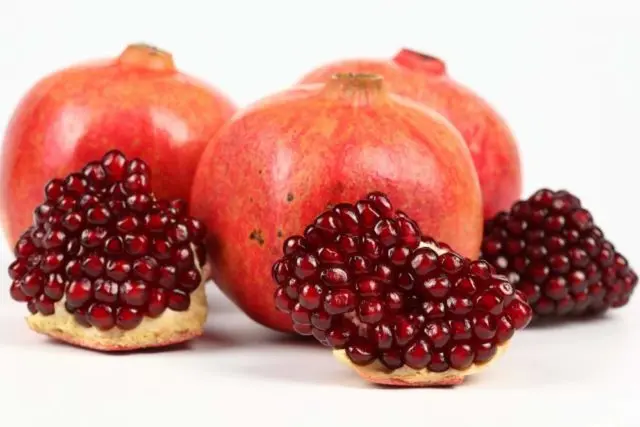
A crop grown in Uzbekistan and Central Asia. Tall but compact shrub. Flattened round shape. Pomegranate weight 250-600 g. The skin is smooth, shiny, beige with a raspberry blush. The grains are elongated, pink. The calyx is cone-shaped with curved teeth. Pomegranate juice turns out to be a light pink shade, sweet in taste. The content of sugar in it is 15%, acid – 0,6%. The fruit ripening period falls on October. Shelf life 60 days. The average yield per bush is 20-25 kg.
Sour pomegranate

A variety of red garnets. It was obtained by scientists from Uzbekistan by selection. Fruit weight on average 450 g. Plant height 4,5 m. Bush lush, branched. The flesh is overly sweet, but due to the inherent acid, the taste is not cloying. A distinctive feature is the peel of a dark green carmine hue. The skin is thick. Ripe fruits have a carmine color inside.
Baby
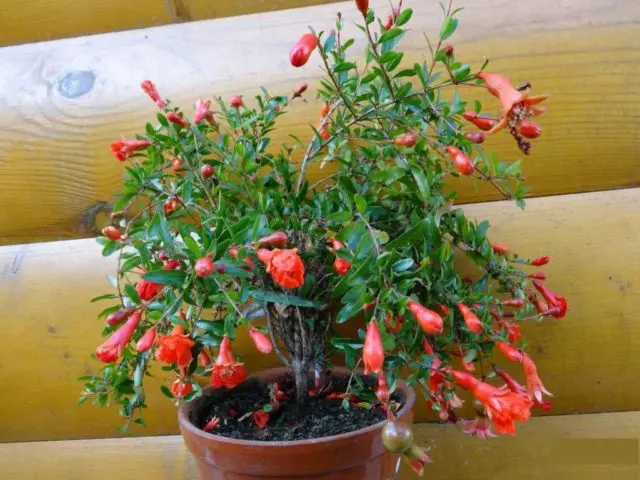
The second name is “Carthaginian apple”. The appearance of the variety was noted in the countries of the Mediterranean, Asia. Due to its miniature size, the variety is suitable for growing indoors. The leaves are oblong, collected in groups. The sheet plate is glossy. The branches are covered with small spines. The fruits are orange or red. More related to decorative varieties. It does not grow above 50 cm. A bush planted in a pot blooms beautifully and for a long time. However, so that it does not lose its attractiveness, the plant must be cut regularly. With the advent of autumn, some of the foliage falls off – this is a natural phenomenon. The grenade needs rest for 1-2 months. New leaves will appear in spring.
Carthage

Homeland – Carthage. The bush is not higher than 1 m in height. Due to the long and abundant flowering, the plant is used as a decoration. Suitable for indoor growing. The foliage is oblong green. Flowers yellow or white. The fruits are small and not intended for human consumption. In terms of taste characteristics, ordinary pomegranate is several times superior to the Carthage variety.
Nana
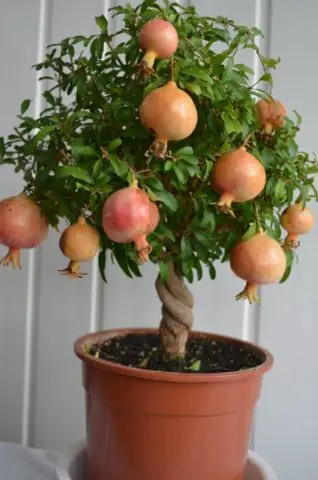
The pomegranate was brought to the European continent from Asia Minor, Iran. The foliage is small, oblong in shape. The height of the shrub is 1 m. It is a reduced copy of a garden bush. The flowers are oblong, sometimes with elongated petals that form fruits. The second type of inflorescence – the petals are short, they do not have an ovary. The fruits are elongated. The Nana variety tastes sweet and sour. The bush is able to completely shed its foliage. It all depends on growing conditions. The plant loves heat, needs daily watering.
Wretched

One of the best Indian varieties of pomegranate. The habitat stretches from the territory of Iran and up to Northern India, capturing the Himalayas. The evergreen bush is large, and the fruits are small. Pomegranate prefers to grow in regions with dry, hot summers and cool winters.
Cossack improved
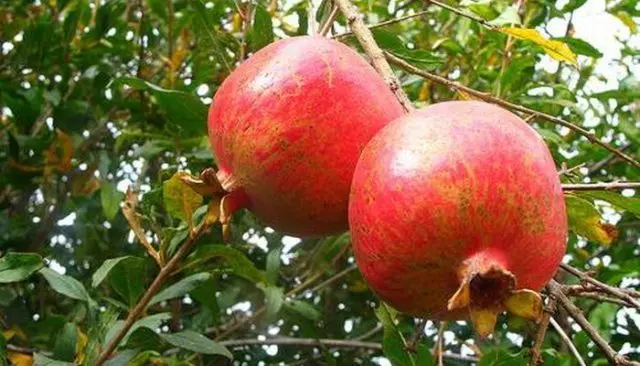
Medium sized pomegranate tree. The fruits are rounded. Cream-colored surface with green stripes all around. Often found carmine skin tone. The skin is thin, yellow inside. The grains are red and pink, large. The taste is sweet.
Guleisha pink
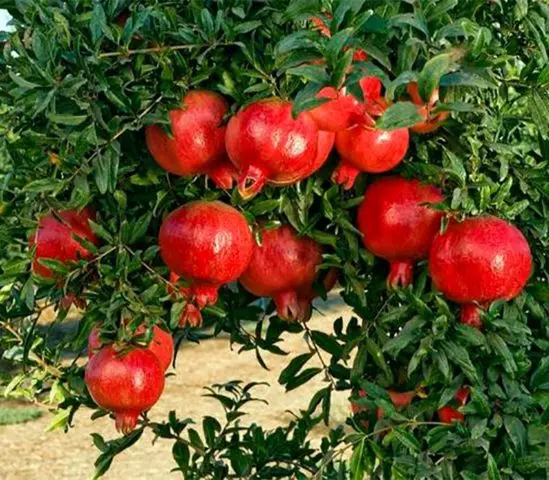
A hybrid variety obtained by breeders in Azerbaijan. Spreading bush grows up to 3 m in height. The branches are covered with thorns. On this variety of pomegranate fruits of different sizes are formed. The fruits are elongated and rounded. The average weight is 250 g. The maximum recorded weight of a berry is 600 g. The shelf life of ripe fruits is no more than 4 months. Harvest is not imported. The pomegranate is sold in the fruit markets of Azerbaijan.
Frost-resistant varieties of pomegranate
Pomegranate is a heat-loving plant that feels comfortable in the tropics. Meanwhile, it is resistant to cold and withstands short-term frosts down to -15 °C. However, even frost-resistant varieties fail to endure a long cold winter. Temperature – 17 ° C is critical for the culture. As a result of a decrease in temperature, the shoots on which the fruits are formed are the first to suffer. The entire aerial part freezes up to the root neck. If the temperature drops even lower, then the roots of the plant die.
Pomegranate honors itself well when the temperature in winter is above -15 ° C. Trees can certainly live in cold regions, but they do not always bloom. Average frost resistance implies sheltering plants for the winter. The warming process is simple, but necessary. Otherwise, the trees will die.
Ak Dona Crimean
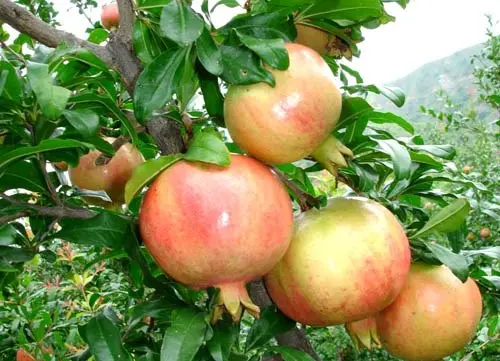
The variety can be easily recognized by the shape of the fruit and the shade of the peel. The color of the skin is yellow-red, with prominent reddish patches. The fruit is strongly flattened at the poles, which clearly differs from other varieties. The size is large. The inner side of the pomegranate of this variety is bright yellow. The color of the grains is dark pink. There is sourness in the taste. The foliage is dark green, 5-7 cm long. The neck is short and thick. The tree is short but wide. Ak Dona Crimean in the process of care does not cause much trouble to the gardener. Grown in the steppe part of the Crimea, Central Asia. The variety is considered medium early. The harvest is at the end of October.
Gulyusha red
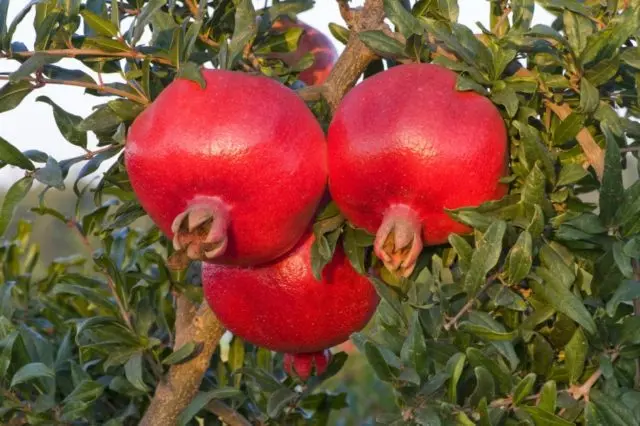
The size of the bush is 3 m in height. The weight of one fruit is 300-400 g. The grains are covered with a thin, pink film. The taste is sweet and sour. The variety is grown in Turkmenistan, Georgia. Ripens, as a rule, in October. Fruit can be stored for 3-4 months. Used to make pomegranate juice. Galusha red grows and bears fruit in a temperate climate, provided shelter for the winter.
Galusha pink

A pink variety of pomegranate appeared in Azerbaijan. The average fruit weight is 200-250 g. It has a more round shape. Apply this variety of pomegranate to obtain juice. Liquid product yield – 54%. Suitable for making sauces. The grains are pink, medium in size. Galusha pink is known for its interesting taste.
Nikitsky early
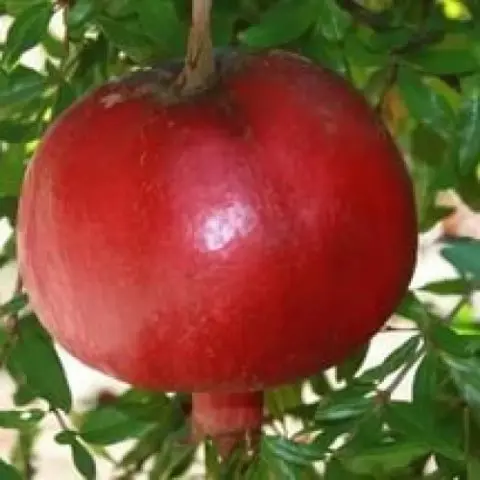
The pomegranate variety was bred in the Nikitsky Botanical Garden, hence the name. A high-yielding species that requires shelter for the winter. Successfully grown Nikitsky early in the central regions of Ukraine. The bush is medium. Height 2 m. Blooms profusely throughout the summer. Inflorescences male and female. The fruits are large. Variety Nikitsky early has an external resemblance to the Ordinary pomegranate.
The sweetest varieties of pomegranate
Taste characteristics are determined by the percentage of sugar and acid. Pomegranate varieties can be divided into three groups: sweet, sweet-sour and sour. The minimum sugar content in sweet fruits is 13%, in sour fruits – 8%.
The taste characteristics of pomegranate are influenced by climatic features of the growing area, variety, stage of fruit maturity. Pomegranate loves a lot of light and heat. Sweet varieties of pomegranate are exported from Tajikistan, Azerbaijan and Central Asian countries. The ideal region for growing fruit is the vicinity of the Talysh Mountains.
For a fruit to be sweet, it must be fully ripe. The main criteria for choosing a ripe fruit:
- peel from red to maroon;
- absence of spots, dents, external defects on the surface;
- a large fruit cannot weigh less than 130 g;
- dried and slightly stiff skin;
- no smell.
The following are the three sweetest varieties of pomegranate with a photo.
Dholka
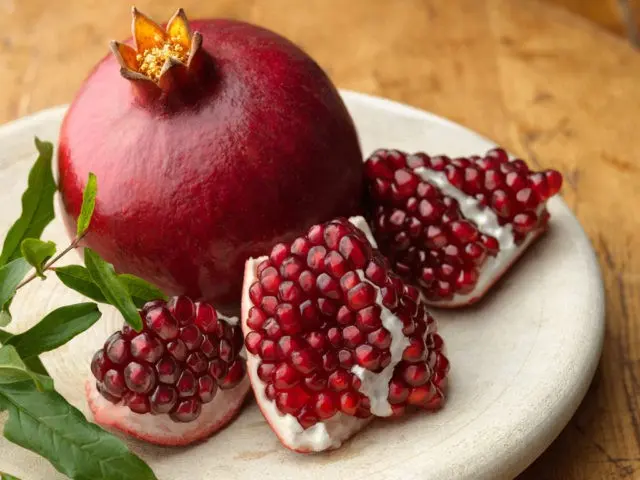
The natural habitat is the territory of India. The fruits are light pink in color. Grains of the same shade or white. The weight of the fruit is 180-200 g. The culture belongs to medium-sized species. Bush height 2 m. Very sweet fruit.
Ahmar
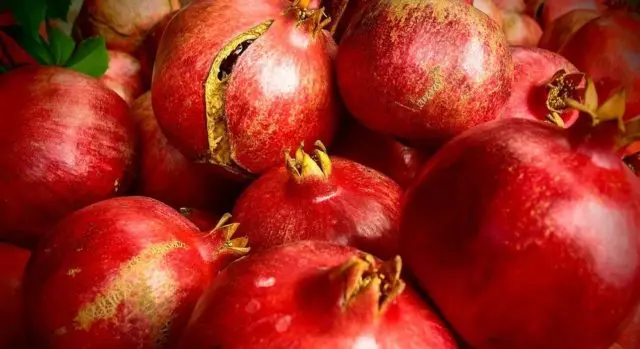
A pomegranate variety of Iranian origin. In terms of the amount of sugar, it is difficult to find an equal to it. The shrub grows up to 4 m high. The inflorescences are red-orange in color, medium in size. The buds appear in May, and the flowering period lasts throughout the summer. The surface of the fruit is pink with a clear green tint. Pink grains. They can be eaten.
Nar-Shirin

Another fruit comes from Iran. In shape, color and taste, it resembles the previous variety. The peel is beige with light green blotches. The inner surface is pink. The grains are almost all even, perfect shape. The shade ranges from light pink to crimson or red. Nar-Shirin is cultivated in the central part of the country. Gardeners breed Akhmar and Nar-Shirin varieties mainly for the domestic market.
Conclusion
Pomegranate varieties, regardless of purpose, require attention and care. Especially in cold climates. Sweet fruits are obtained in warm, southern countries. The desired result is influenced by the soil, the implementation of cultivation rules. If desired, in the regions of Central Our Country, you can grow a pomegranate tree, but in a greenhouse.









